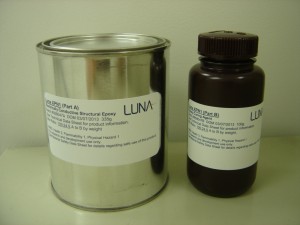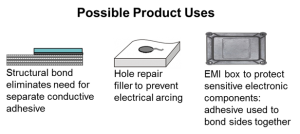Electrically conductive structural adhesives: Simplifying complex bonding problems
 Dealing with electrical threats in the aerospace community is an extremely difficult and challenging problem. Electrostatic discharge (ESD) and electromagnetic interference (EMI) can catastrophically damage critical aircraft electronics and jam radio and radar signals. Similarly, ESD and EMI threats can render expensive and mission-critical satellites inoperable. At joints, gaps, and fastener locations it is very important to have continuous electrical conductivity to protect against these unwanted threats and maintain electronic equipment performance. Incumbent solutions involve both an electrical bridging component (e.g. a costly silver adhesive or wire mesh) and a structural adhesive. This multi-material solution results in high costs, extra weight, and application complexity. In response, Luna has developed a solution that reduces material and man-hour costs: Luna’s XPN1 and XPC1 conductive structural adhesives
Dealing with electrical threats in the aerospace community is an extremely difficult and challenging problem. Electrostatic discharge (ESD) and electromagnetic interference (EMI) can catastrophically damage critical aircraft electronics and jam radio and radar signals. Similarly, ESD and EMI threats can render expensive and mission-critical satellites inoperable. At joints, gaps, and fastener locations it is very important to have continuous electrical conductivity to protect against these unwanted threats and maintain electronic equipment performance. Incumbent solutions involve both an electrical bridging component (e.g. a costly silver adhesive or wire mesh) and a structural adhesive. This multi-material solution results in high costs, extra weight, and application complexity. In response, Luna has developed a solution that reduces material and man-hour costs: Luna’s XPN1 and XPC1 conductive structural adhesives

 Our adhesives provide high strength structural performance coupled with continuous electrical conductivity thereby providing multifunctional service in one adhesive package. The adhesives are finding use across the aerospace community in situations that require high strength and mitigation of ESD and/or EMI. The use of our all-in-one adhesives reduce and, in some cases, eliminate the need to outfit structures with costly combinations of electrical and mechanical solutions.
Our adhesives provide high strength structural performance coupled with continuous electrical conductivity thereby providing multifunctional service in one adhesive package. The adhesives are finding use across the aerospace community in situations that require high strength and mitigation of ESD and/or EMI. The use of our all-in-one adhesives reduce and, in some cases, eliminate the need to outfit structures with costly combinations of electrical and mechanical solutions.
Our adhesives achieve multifunctional performance through the careful incorporation and dispersion of conductive fillers within high performance adhesive resins. This process creates conductive adhesives with working life, cure time, and application and mechanical properties similar to those of the adhesive products currently used by the military, commercial aircraft and spacecraft manufacturers, and maintainers. We have put the adhesives through extensive tests both internally and externally by third party prime integrators. Tests include bond resistance, volume resistivity, shielding effectiveness, lap shear strength, outgassing characteristics, and numerous environmental exposure tests. Results indicate the adhesives are suitable for a range of stringent performance and environmental applications across the DoD and commercial aerospace. We are actively working with numerous parties to determine the applicability of these adhesives to relevant platforms.
For more information on Luna’s XPN1 conductive structural adhesive, please see our technical data sheet (TDS) or contact us as at [email protected].
Click here to purchase.